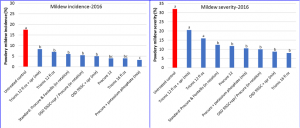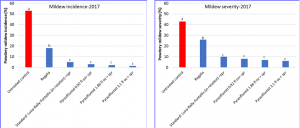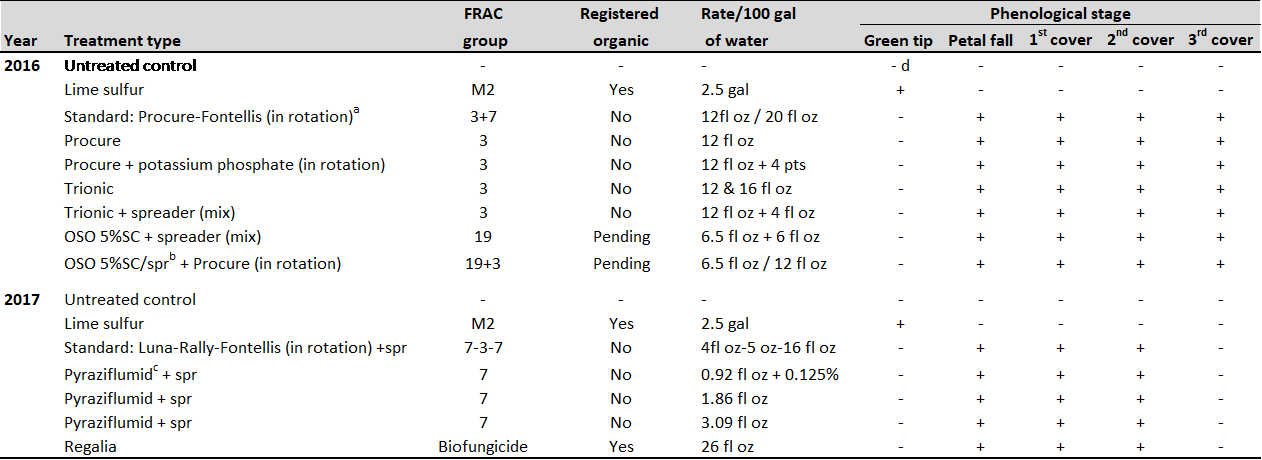Written by: Achour Amiri, WSU Plant Pathology, TFREC, Wenatchee, WA
In 2016 and 2017 several products were tested from green tip to 2nd or 3rd covers for the control of apple powdery mildew (Table 1). Products were tested on Granny Smith, a cultivar highly susceptible to this disease. Treatments were applied from April to early June and disease incidence and severity were determined on 10 shoots of 4 replicate-trees for each treatment. Lime sulfur was applied to all trees, except on untreated control, at green tip then followed by the respective treatment shown in Table 1.
Table 1. List of fungicides and rates used for powdery mildew at different phenological stages in 2016 and 2017.
a In a rotation program, the first fungicide was applied first then the second fungicide at the following growth stage and so for.
b Spr indicates a spreader used in mixture with the fungicide.
c Pyraziflumid is an experimental fungicide and has not yet been registered.
d – or + indicate if treatment was not applied or applied, respectively.
2016 growing season
In 2016, powdery mildew pressure was relatively low in the untreated control (18%) and all treatments applied significantly reduced mildew incidence compared to the untreated control (Figure 1 left). TrionicTM a new generic product of Procure, applied at 12 fl oz alone, or in combination with a spreader, was the least effective among the treatments tested. However, increasing the rate to 16 fl oz, significantly increased Trionic efficacy and reduced incidence to 4% compared to 7% at 12 fl oz. OSOTM is a new preharvest fungicide with a singular mode of action. As tested herein, it had an efficacy equivalent to that of Procure. Interestingly, rotating potassium phosphate with Procure increased Procure efficacy. All treatments, except Trionic at 12 fl oz, reduced mildew severity significantly, as compared to the control (Figure 1 right). Trionic at 16 fl oz and OSO were most effective in reducing mildew severity.

2017 growing season
The 2017 season was more conducive to powdery mildew as incidence in the untreated trees was as high as 52% (Figure 2, left). All treatments reduced mildew incidence compared to the control. The organic product Regalia was the least effective among the treatments with about 18% incidence. On the other hand, the experimental Group 7 fungicide (pyraziflumid) was the most effective regardless of the rate used. Similar trends in efficacy of the applied fungicides was observed on mildew severity (Figure 2, right).

Summary
The new triflumizole fungicide formulated as Trionic, similar to Procure, should be effective if applied at 16 fl oz/ac. Reducing the application rate below 16 fl oz/ac would significantly reduce efficacy. In this study, mixing Trionic with SB56 spreader resulted in more mildew incidence and severity. This could be a result of incompatibility that reduced the efficacy of the active ingredient. Therefore, Trionic should be mixed carefully with proper adjuvants to ensure compatibility. Another promising product to fight mildew on apple is OSOTM (FRAC group 19) as it is efficacy was comparable to that of Procure. Interestingly, the rotation OSO-Procure seems to provide similar levels of control compared to situations when either fungicide was applied separately. This finding may indicate that OSO could be recommended as a rotational partner with other fungicides having different modes of action so as to reduce fungicide resistance development in mildew. If OSO becomes registered for use in organic orchards, where mildew is a bigger problem compared to conventionally managed orchards, it would be a very useful tool to fight this disease.
Procure is one of the most effective fungicides for mildew management. Interestingly, rotating it with potassium phosphate seemed to improve mildew control. One possible hypothesis to explain why rotation provides better numerical efficacy than Procure alone may be potassium phosphates ability to trigger host defense as shown in other crops and other powdery mildew species. The experimental FRAC group 7 fungicide-pyraziflumid seems to be highly effective even under high powdery mildew pressure conditions, like those in 2017. Registration is expected in two or three years, but it could be a more effective fungicide than some existing Group7 fungicides. Although, the biopesticide Regalia reduced mildew compared to the control, its overall efficacy was only fair. Combination with other alternative products labeled for organic orchards may improve its efficacy.
As an overall approach to control fungal pathogens, standard management programs should include fungicides with different modes of action. The standard treatments tested herein were effective although some other treatments seemed numerically, but not significantly, more effective. Therefore, we recommend observing rotations as it is a better long-term strategy to extend the life span of effective chemicals compared to an extensive use of the same fungicides.
Contact
Dr. Achour Amiri
Tree Fruit Research and Extension Center
509-663-8181 ext 268
Disclaimer:
Some of the pesticides discussed in this presentation were tested under an experimental use permit granted by WSDA. Application of a pesticide to a crop or site that is not on the label is a violation of pesticide law and may subject the applicator to civil penalties up to $7,500. In addition, such an application may also result in illegal residues that could subject the crop to seizure or embargo action by WSDA and/or the U.S. Food and Drug Administration. It is your responsibility to check the label before using the product to ensure lawful use and obtain all necessary permits in advance.
No endorsement is intended for products mentioned, nor is lack of endorsement meant for products not mentioned. The author and Washington State University assume no liability resulting from the use of pesticide applications detailed in this report.
Fruit Matters articles may only be republished with prior author permission © Washington State University. Reprint articles with permission must include: Originally published by Washington State Tree Fruit Extension Fruit Matters at treefruit.wsu.edu and a link to the original article.


